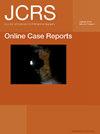Acanthamoeba and staphylococcal keratitis with epithelial ingrowth after laser in situ keratomileusis
Q4 Medicine
引用次数: 0
Abstract
Introduction: A rare case of Acanthamoeba and staphylococcal keratitis after femtosecond laser–assisted laser in situ keratomileusis (LASIK), managed medically and surgically (with flap lift, scraping, and povidone–iodine 5% application) is reported. Patient and clinical findings: A 25-year-old woman presented 30 months after myopic LASIK with a painless loss of vision in the right eye. Visual acuity was 20/32, and a focal stromal opacity was observed. Diagnosis, intervention, and outcomes: The patient underwent flap lift, scraping, and application of povidone–iodine 5% to the flap interface. Samples were sent to the microbiology department for microscopic, culture, and sensitivity, and the patient was commenced with topical fluconazole, levofloxacin, and fusidic acid. Giemsa staining demonstrated 2 Acanthamoeba cysts. Microscopic examination revealed gram-positive cocci and pyogenic cells. Culture on a nonnutrient agar with a lawn of Escherichia coli identified the gram-positive organism Staphylococcus aureus. The clinical situation improved, and topical steroids were added. Mild epithelial ingrowth was noted at 4 months after flap lift; however, the growth remained stable and was under observation. The final visual outcome was good (visual acuity 20/25). Conclusions: This case emphasized the importance of precise microbiological diagnosis and consideration of early flap lift in post-LASIK infectious keratitis.激光原位角膜磨镶术后棘阿米巴和葡萄球菌性角膜炎伴上皮向内生长
简介:报告一例罕见的棘阿米巴和葡萄球菌性角膜炎,在飞秒激光辅助激光原位角膜磨圆术(LASIK)后进行医学和外科治疗(皮瓣提升,刮痧,应用5%聚维酮碘)。患者和临床表现:一名25岁的女性在近视LASIK术后30个月出现右眼无痛性视力丧失。视力20/32,可见局灶性间质混浊。诊断,干预和结果:患者接受皮瓣提升,刮痧,并在皮瓣界面应用5%聚维酮碘。样品送到微生物科进行显微镜、培养和敏感性检查,患者开始使用局部氟康唑、左氧氟沙星和夫西地酸。吉姆萨染色示2个棘阿米巴囊肿。镜检显示革兰氏阳性球菌和化脓性细胞。在无营养琼脂培养基上培养大肠杆菌,鉴定出革兰氏阳性菌金黄色葡萄球菌。临床情况有所改善,并给予局部类固醇治疗。皮瓣提起后4个月轻度上皮向内生长;然而,增长保持稳定,并处于观察之中。最终视觉效果良好(视力20/25)。结论:本病例强调了在lasik术后感染性角膜炎中精确的微生物学诊断和早期皮瓣提升的重要性。
本文章由计算机程序翻译,如有差异,请以英文原文为准。
求助全文
约1分钟内获得全文
求助全文

 求助内容:
求助内容: 应助结果提醒方式:
应助结果提醒方式:


